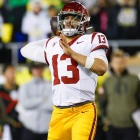O'Bannon case: O'Bannon timeline | How Vaccaro created case | More trial content
Approximately 100,000 current and former college football and men's basketball players would be able to claim up to $5,000 per year for past appearances on NCAA-branded video games, according to terms of the proposed NCAA settlement filed Monday.
On June 9, lawyers for the NCAA and former Arizona State and Nebraska quarterback Sam Keller announced they had agreed on a proposed $20 million deal to settle a case about the use of college athletes' names and likenesses in video games. That was on top of the previous $40 million settlement by Electronic Arts and Collegiate Licensing Company to end four separate lawsuits, including Keller's, over video games.
The combined $60 million settlement funds represents about 75 percent of what a trial victory would have provided, Keller's lawyers wrote in their motion seeking court approval. The plaintiffs projected winning in court would have been worth between $80 and $120 million and wrote that the settlement "ensures a very favorable outcome."
The terms of the proposed NCAA settlement were filed Monday in the Northern District of California. U.S. District Judge Claudia Wilken will hold a preliminary approval hearing Thursday in Oakland, Calif., for the NCAA and the EA settlements, and must still approve the deals.
If Wilken approves, the notice and claims for the NCAA and EA settlements would occur together in the coming months. Because the settlements are related, the Keller lawyers said they intend to create a cap for the combined settlements at $5,000 per roster appearance ($1,818 for the NCAA settlement and $3,182 for the EA settlement).
That means a player who appeared in four video games could receive $20,000, if the settlement claims rate is at 10 percent. Different claims rates would impact the amount, along with the nature of appearing in the video game (being on a roster and having a photograph are the distinguishing factors).
Video game trust fund switches to college fund
The $5,000 per year cap would limit recoveries at participation rates less than approximately 10 percent. If the participation rate is lower than 10 percent, the Keller lawyers said they will create a program to distribute any residual funds into a trust to class members who did not file a claim.
The fund would work through NCAA members who are willing to promote the program and assist in locating class members. Those class members would be compensated $500 per appearance. If the trust fund is not exhausted after five years, the video game fund would convert into a hardship-based scholarship fund to assist class members who did not graduate and wish to return to college.
The NCAA settlement states that the Keller attorneys' fees won't exceed 29 percent ($5.8 million) and their legal expenses won't go over $500,000. In the previous EA settlement, the plaintiffs' attorney fees involving multiple parties woudn't exceed 33 percent ($13.2 million) and expenses would not go over $2.5 million.
The named plaintiffs in the NCAA right-of-publicity class -- Keller, Bryan Cummings, Lamar Watkins and Bryon Bishop -- are each scheduled to receive $5,000 from the NCAA settlement. Keller also would receive $15,000 from the EA settlement, along with $15,000 each to former UCLA basketball star Ed O'Bannon and former Rutgers football player Ryan Hart.
Also in the EA settlement, $5,000 each would go to named O'Bannon plaintiffs Oscar Robertson, Bill Russell, Harry Flournoy, Alex Gilbert, Sam Jacobson, Thad Jaracz, David Lattin, Patrick Maynor, Tyrone Prothro, Damien Rhodes, Eric Riley, Bob Tallent, Danny Wimprine, Ray Ellis, Tate George, Jake Fischer, Jake Smith, Darius Robinson, Moses Alipate, Chase Garnham, and Shawne Alston.
The EA settlement included an allocation to "roster-only" plaintiffs, meaning players who had no avatar in the video games. The Keller plaintiffs say even removing that allocation leaves $55 million for claims involving misappropriation of publicity rights.
How much are most players paid?
Not all video game appearances would be treated equally. Each season video-game roster appearance since May 5, 2007 is worth eight times the amount from before that date. The Keller plaintiffs say that's because the class cannot make a right of publicity claim for certain years that fall outside the applicable statute of limitations.
For players who appeared in video games from 2003 until May 5, 2007, the amount per roster year appearance based on claims rates is as follows: $20.76 for 100 percent claim rate; $41.52 for 50 percent; $83.05 for 25 percent; $207.62 for 10 percent; and $415.25 for 5 percent.
For players who appeared in video games after May 5, 2007 until the present date, the amount per roster year appearance is as follows: $166.10 for 100 percent claim rate; $332.50 for 50 percent; $664.39 for 25 percent; $1,660.98 for 10 percent; $3,321.97 for 5 percent. (The 5 percent rate would hit the settlement cap of $1,818.18.)
The Keller plaintiffs estimate there are approximately 177,447 roster appearances in the class, with 112,263 appearances (63 percent) occurring since May 2007. A current or former player is eligible if a player is listed on a roster of a school that appears in the video games and his assigned number appears on a virtual avatar of the same team.
The Keller plaintiffs say they have a working database of players from NCAA-branded video games, which has over 3,900 teams and 75,000 players. The plaintiffs put together what they call the "Real Roster Database" to compare EA's roster information that's being called the "Virtual Roster Database." The intention is to provide matches of real players with their virtual counterparts in video games.
Proving a likeness exists will be based on matching uniform number, school, division, sport, position and home state. The merged database projects approximately 77,550 appearances by class members in NCAA football video games and 18,400 appearances by class members in NCAA basketball video games, meaning roughly 95,900 current and former players are eligible.
As part of the settlement, the NCAA agreed to contact member schools to locate class members' last known contact information. "To the extent that a member institution or affiliated alumni association declines to provide such information, Class Counsel shall subpoena such member institution and affiliated alumni association for that information," the Keller plaintiffs wrote.
There's a provision in the settlement that allows the NCAA to rescind the agreement if 1,000 settlement class members opt out. A similar provision was put in the EA settlement with a redacted opt-out number.
The Keller lawyers wrote in their motion that the NCAA $20 million settlement compared to the $40 million EA settlement "is notable, considering funds in this (NCAA) Settlement will come from a defendant that, it is alleged, did not directly use player likenesses, and is instead sued as a conspirator."
NCAA chief legal officer Donald Remy said in a statement the settlement terms "signifies an opportunity to provide complete closure to the video game plaintiffs, but should not be considered pay for performance."




















